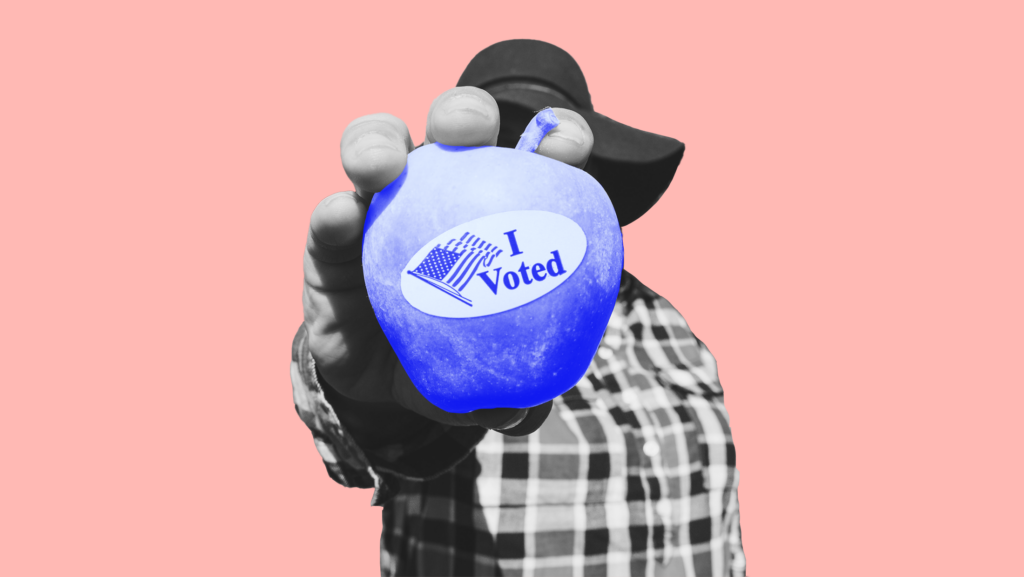Black and Brown Voters Are Building Power in Rural America

In the weeks leading up to Election Day 2022, dozens of Latino volunteers with We the People Action Fund — many of them undocumented and unable to vote themselves — registered farmworkers to vote as they came off their shifts in the apple orchards of Grand Traverse County in rural Michigan. Many of the farmworkers were citizens, but had not registered to vote or were registered and had never voted. Everyone was clear about what they wanted: driver’s licenses for their undocumented friends and family members.
Even though the 103rd House District is 96% white and historically conservative, the farmworkers helped defeat an entrenched incumbent who had killed a driver’s license bill many times. This bill would restore the right of every capable Michigan driver, regardless of their paperwork or immigration status, to obtain a driver’s license, a right they had until 2008. In his place, they elected Betsy Coffia, a champion of driver’s licenses for all and other progressive causes, by 765 votes.
In electing Coffia, the farmworkers were key to winning a Democratic trifecta in Michigan for the first time in almost 40 years. But folks didn’t organize all summer just for a politician or to help the Democratic Party. They did it so that the people they love could move around freely without the fear of persecution.
This victory symbolizes the growing power of people of color in rural communities across the country. In politics, “rural” is used as a synonym for white and conservative. But rural America has grown increasingly racially diverse over the past decade. Nationwide, one in four folks in rural areas is a person of color — around 11 million people.
Traditional campaigns that overlook this fact are missing the chance to build relationships with Black and Latino people in rural areas. Given that battleground states like Arizona, Georgia, Michigan, Pennsylvania and Wisconsin are won or lost by a handful of votes, rural people of color could be decisive in the 2024 election cycle.
At New Georgia Project Action Fund, we intentionally engage Georgians living in the rural Black Belt — a strip of 29 counties across the southern middle of the state that have a high Black population. When we knock on their doors, residents in these areas are eager to talk about their economic concerns, which is understandable as Georgia’s minimum wage stands at $5.15 an hour, or their health care needs, given that eight hospitals have shut down in rural Georgia over the past 10 years.
Organizations like ours will keep building power with Black and brown folks in rural areas, but we can’t be the only ones.
This openness means that there is an opportunity to engage people in rural areas who haven’t been previously engaged. The political industry calls these folks “low propensity” voters because they haven’t voted before or have voted inconsistently, and, in their view, are not worth time and investment.
But we call them “high opportunity” voters because, based on our experience, they will become civically active if they are engaged and invested in. This includes having high-quality conversations with them, connecting the dots between who is on the ballot and the impact on their daily lives and following up with them over the long term — whether there is an election coming up or not.
Some rural counties show up red on a political map, but they have the potential to become purple with more investment and engagement. For example, based on our calculations of Georgia secretary of state data, between the 2020 November general election and 2022 December runoff for U.S. Senate, the Democratic margin in Clinch County in southeastern Georgia increased by four points. In Early County in southwest Georgia on the Alabama border, the gain was 4.6 points, and in Johnson County in Georgia’s Black Belt, it was 5.3 points.
We’re seeing that organizing makes the difference in other swing states, as well. Living United for Change (LUCHA) in Arizona saw that rural communities were growing, but no one was talking to these folks. In 2022, they expanded their voter registration, community organizing and get-out-the-vote efforts to five new counties across the state and in border towns. One of those places was Douglas, Arizona, where their efforts helped increase voter participation by eight points, according to LUCHA’s internal research.
It may be easier for traditional campaigns to focus on more liberal urban and suburban areas, but that’s leaving out entire communities that have been intentionally excluded for too long and that, when engaged, will support a progressive agenda. Organizations like ours will keep building power with Black and brown folks in rural areas, but we can’t be the only ones. We need year-round, committed engagement from grassroots organizations and political parties if we are going to build a multiracial democracy that makes life better for all of us.
Kendra Cotton is the CEO of New Georgia Project Action Fund. New Georgia Project Action Fund increases the civic participation of the New Georgia Majority — Black, Latinx, AAPI and young Georgians — and other historically marginalized communities by building grassroots political power in support of progressive leaders, policies and issues.
Art Reyes III is the founding executive director of We the People Action Fund. We the People Action Fund is building a multiracial, working-class movement to rewrite the rules and make Michigan a place where everyone flourishes and every community thrives for generations to come, no exceptions.